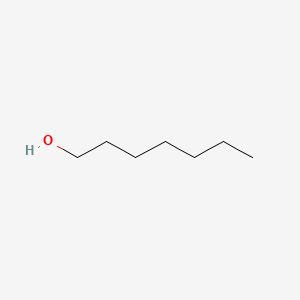| MeSH term | MeSH ID | Detail |
|---|---|---|
| Eye Burns | D005126 | 13 associated lipids |
| Ventricular Dysfunction, Left | D018487 | 33 associated lipids |
| Tachycardia, Ventricular | D017180 | 9 associated lipids |
| Heart Injuries | D006335 | 6 associated lipids |
| Wounds, Gunshot | D014948 | 2 associated lipids |
| Tachycardia, Ectopic Atrial | D013612 | 1 associated lipids |
n-heptanol
N-heptanol is a lipid of Fatty Acyls (FA) class. N-heptanol is associated with abnormalities such as Corneal Neovascularization. N-heptanol often locates in Epithelium and Structure of corneal epithelium. The related lipids are Heptanol.
Cross Reference
Introduction
To understand associated biological information of n-heptanol, we collected biological information of abnormalities, associated pathways, cellular/molecular locations, biological functions, related genes/proteins, lipids and common seen animal/experimental models with organized paragraphs from literatures.
What diseases are associated with n-heptanol?
n-heptanol is suspected in Corneal Neovascularization and other diseases in descending order of the highest number of associated sentences.
Related references are mostly published in these journals:
| Disease | Cross reference | Weighted score | Related literature |
|---|
Possible diseases from mapped MeSH terms on references
We collected disease MeSH terms mapped to the references associated with n-heptanol
PubChem Associated disorders and diseases
What pathways are associated with n-heptanol
There are no associated biomedical information in the current reference collection.
PubChem Biomolecular Interactions and Pathways
Link to PubChem Biomolecular Interactions and PathwaysWhat cellular locations are associated with n-heptanol?
Visualization in cellular structure
Associated locations are in red color. Not associated locations are in black.
Related references are published most in these journals:
| Location | Cross reference | Weighted score | Related literatures |
|---|
What functions are associated with n-heptanol?
There are no associated biomedical information in the current reference collection.
What lipids are associated with n-heptanol?
Related references are published most in these journals:
| Lipid concept | Cross reference | Weighted score | Related literatures |
|---|
What genes are associated with n-heptanol?
There are no associated biomedical information in the current reference collection.
What common seen animal models are associated with n-heptanol?
There are no associated biomedical information in the current reference collection.
NCBI Entrez Crosslinks
All references with n-heptanol
Download all related citations| Authors | Title | Published | Journal | PubMed Link |
|---|---|---|---|---|
| Li C et al. | Regulatory effect of connexin 43 on basal Ca2+ signaling in rat ventricular myocytes. | 2012 | PLoS ONE | pmid:22577485 |
| Haddock RE et al. | Diet-induced obesity impairs endothelium-derived hyperpolarization via altered potassium channel signaling mechanisms. | 2011 | PLoS ONE | pmid:21283658 |
| Rentero C et al. | Functional implications of plasma membrane condensation for T cell activation. | 2008 | PLoS ONE | pmid:18509459 |
| Poncelet J et al. | Semantic knowledge influences prewired hedonic responses to odors. | 2010 | PLoS ONE | pmid:21079734 |
| Xu W et al. | Odorant-binding proteins of the malaria mosquito Anopheles funestus sensu stricto. | 2010 | PLoS ONE | pmid:21042539 |
| Nishizawa H et al. | Causes of abnormal Ca2+ transients in Guinea pig pathophysiological ventricular muscle revealed by Ca2+ and action potential imaging at cellular level. | 2009 | PLoS ONE | pmid:19768114 |
| Hung J and Colicos MA | Astrocytic Ca(2+) waves guide CNS growth cones to remote regions of neuronal activity. | 2008 | PLoS ONE | pmid:19002247 |
| Tse G et al. | Atrial Anti-Arrhythmic Effects of Heptanol in Langendorff-Perfused Mouse Hearts. | 2016 | PLoS ONE | pmid:26872148 |
| Brokamp C et al. | Electrophysiology of single and aggregate Cx43 hemichannels. | 2012 | PLoS ONE | pmid:23112846 |
| Oite T | Exploring the mechanisms of renoprotection against progressive glomerulosclerosis. | 2011 | Proc. Jpn. Acad., Ser. B, Phys. Biol. Sci. | pmid:21422741 |
